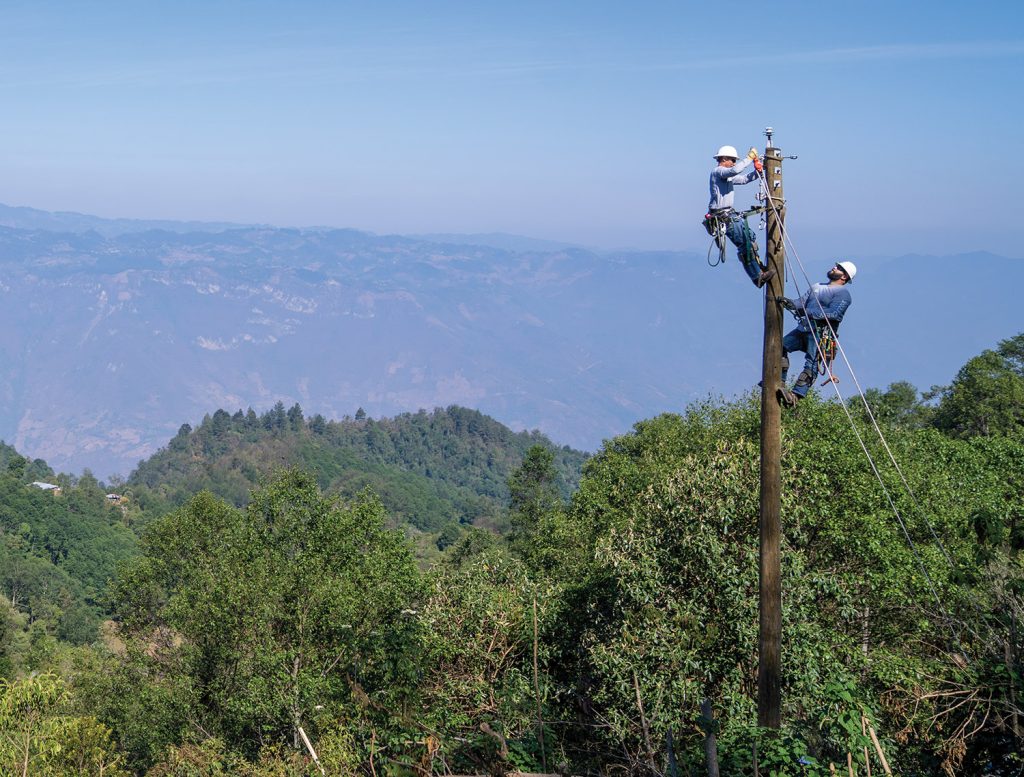
The Guatemalan villager stood just inside the door frame of the cabin she shares with her husband in Peña Roja, high in the mountains near Mexico. Asked what she thought about the momentous event about to occur — electricity in her home for the first time — she said rather matter-of-factly through an interpreter, “What am I going to think? I’m happy because I can see.”
She flipped the switch installed beside the door and a bare LED bulb lit up above and behind her right shoulder. This brought a broad smile to her weathered face.
Down the mountain, her husband boiled water so the 14 Indiana electric cooperative lineworkers who brought electric power to the tiny remote village could have hot showers. When told he now had electricity in his home, tears welled in his eyes.
“To know energy is already in my house … thank you,” he said in the Spanish dialect of northwestern Guatemala. Through an interpreter, he said, “Thank you to Indiana for sending you to this place. Thank you for remembering these poor and humble people. Here we are, very happy to have you here in front of us and that you continued to have us in your heart. Hopefully, we continue having this kind of happiness.”
Bringing hope is the mission of Project Indiana — subtitled Empowering Global Communities for a Better Tomorrow.

For just over two weeks in late April and May, the lineworkers from Indiana electric cooperatives continued the international initiative to bring electricity to developing remote areas of Guatemala. This excursion, the fifth since Indiana began sending crews to the country in 2012, took them to elevations of 11,000-12,000 feet in the western mountains near the Mexican border.
When completed, 26 homes had electricity for the first time. The project team noticed the villagers moving a chest freezer into one of the homes at which power had been turned on. The villagers had been anticipating this time for so very long, and they were anxious to begin using modern appliances. This freezer will enable them to preserve things like meat so they can have regular protein in their diets.
“It’s a great opportunity to help improve their quality of living and give the children a better future,” said Kevin Bay, a lineman from JCREMC, headquartered in Franklin, making his second Project Indiana trip.
Once work was completed in Peña Roja, the Project Indiana team assisted the local cooperative with some necessary maintenance to several poles on the Mexican border, and they celebrated alongside their new friends from Peña Roja.
A few from the team had quietly made a “short” trip to the community of Cuilco to do a little shopping for gifts. After pooling their money, the team returned with 65 pairs of shoes, 65 coloring books, four soccer balls, piñatas, fireworks and some backpacks. Each Peña Roja child received a new pair of shoes and a coloring book. The lineworkers offered a version of a cornhole contest to give away the backpacks. They played soccer with the children and celebrated the festive day with fireworks and piñatas.
The next trip is already being planned for 2025.
More photos and information can be found at ProjectIndiana.org.


Project Indiana Crew
Project Crew
Matt Bassett, Tipmont
Kevin Bay, JCREMC
Michael Bowman, Boone REMC
Cody Campbell, South Central Indiana REMC
Nathan Clayton, Clark County REMC
Collin Crabtree, Decatur County REMC
Ethan DeWitt, Northeastern REMC
Austin Gearlds, NineStar Connect
Tom Gettinger, Henry County REMC
Clint Heeke, Southern Indiana Power
Frank Leach, Carroll White REMC
Terry Minic, Paulding Putnam Electric Cooperative, Inc.
Jason Morrison, Jackson County REMC
Michael Newlin, Orange County REMC
Support Team
Joe Banfield, Indiana Electric Cooperatives
Jamie Bell, NineStar Connect
Ron Holcomb, Tipmont
Chris Todd, Northeastern REMC
You can help support Project Indiana
To support Project Indiana, visit projectindiana.org/support. All donations are tax deductible. One hundred percent of your donation will be used to help those who currently do not have access to the opportunities we take for granted.




